Estimated reading time: 5 minutes
It’s common to see tiny little Rutherglen bugs on your fruit tree in summer. They sometimes show up when the fruit is starting to ripen. Have you noticed any on your fruit?
Related Articles
6 Steps to Looking After Fruit Fly and Bird Nets
Fruit fly and bird nets are key to your fruit growing success. These 6 simple steps to look after them properly will help them last longer.
Could grasshoppers be eating your fruit?
Grasshoppers can do damage to fruit and to leaves on your fruit trees, but it’s possible to keep them under control with these strategies.
Why you should pick up fruit from the ground
Picking up your fruit from the ground is the first principle of organic orchard hygiene, and one of your best lines of defence against pests.
We first learned about these little bugs the hard way. One very wet year we (and everyone else trying to grow fruit on the east coast of Australia) had a plague of them. Thankfully we’ve seen very few since then.
However, they continue to show up in different places, so it’s a good time to show you what to look for, and what to do.

Identifying bugs on your trees and fruit
If you have bugs on your fruit, the first step is to try to identify them. In particular, you need to rule out whether you have fruit fly or not because fruit fly has a specific management plan.
The bugs in these photos are called Rutherglen bugs. They are tiny, and a nuisance, and if there are enough of them they can wreck your fruit.
Rutherglen bugs are in a category of insects called sapsuckers. They suck the juice out of your fruit and large numbers can cause the fruit to shrivel up.
The year that we had a plague a small proportion of our peaches had so much juice sucked out that they weren’t usable. Luckily most were still fine and we were able to sell them at the market as usual.
The bugs can leave a slightly sticky residue on the fruit as well, but this washes off.
Why do some bugs come and go?
Interestingly, we’ve barely seen them since. This is often the way with ‘plagues’—they’re usually the result of an imbalance in the ecosystem that has temporarily favoured one insect over another. They usually quickly get back into balance and numbers go back to normal (i.e., hardly any).
This is in direct contrast to pests that tend to stick around year after year. Fruit flies and earwigs are in this category, though their population density can still fluctuate widely depending on the season.
So, why do plagues disappear?
Mainly because these insects have a lot of predators. Nature tends to get these population explosions under control all by herself, as long as you have decent biodiversity in your garden, and IF you don’t mess things up by using pesticides.
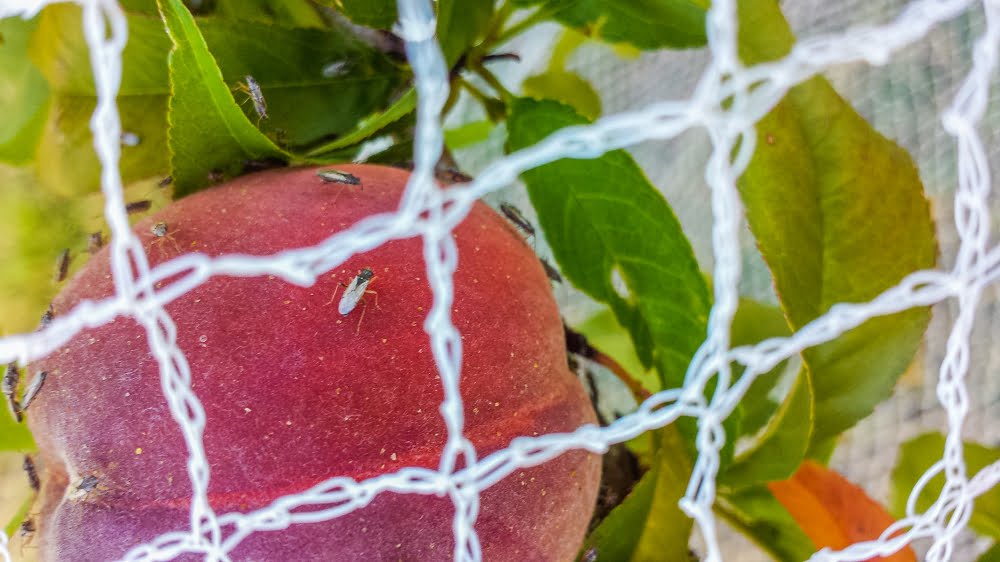
Protecting fruit from bugs
When you are experiencing an outbreak it would be nice to protect your fruit, right? Most gardeners don’t want to just abandon the crop to the pest outbreak and hope that things correct themselves by next year.
You want to take action, right?
Before we give you some practical tips for what to do, we’d like to suggest what NOT to do – and that’s to reach for a bottle of insecticide.
Using off-the-shelf chemicals to kill things in your garden is a potential recipe for disaster. At best, they’re often ineffective (and you’re giving yourself and your family an extra dose of chemicals in your diet).
At worst you may accidentally kill good insects and maybe even make the original problem worse. You’ll also be making your garden a much less welcoming place. It’s really easy to do more damage than you can prevent.
Practical solutions
Here are our top 4 suggestions:
- Hose the tree when it has a large swarm of bugs on it. This should discourage the bugs that are on the tree at the time. If there are lots around in the garden the tree will probably be re-infested and you may need to repeat.
- If you have chickens or other poultry, confine them to the area around your fruit trees if possible. They’ll love to eat the bugs. As above, if there are lots of bugs around, the tree may be re-infested when you remove the chooks.
- Protect the tree with a very fine net. Use the same sort you would use to prevent fruit fly from getting to the fruit. As you can see in the photo above, they easily get through regular-sized bird netting.
- As a last resort, you can try a home-made organic spray. Be very careful if you do this. Even though home-made sprays are safer than bought chemicals, it can still be easy to do more harm than good by killing the predator insects that will be eating the Rutherglen bugs. You may accidentally make the problem last longer.
Long-term bug management strategies for your fruit trees
The key message is don’t worry too much about them. They’re quite hard to control in the short term, but they often won’t do too much damage, and next season the plague probably won’t be back.
Concentrate instead on the long-term strategies for managing these bugs (and all the other pests as well):
(1) continuous soil improvement,
(2) continuous biodiversity improvement,
(3) continue to educate yourself about individual pests that might cause problems for your fruit, including their lifecycle, how to identify them, tips for prevention, and treatment strategies.
The best place to start? Read our other blogs about pest control.
Related Articles
6 Steps to Looking After Fruit Fly and Bird Nets
Fruit fly and bird nets are key to your fruit growing success. These 6 simple steps to look after them properly will help them last longer.
Could grasshoppers be eating your fruit?
Grasshoppers can do damage to fruit and to leaves on your fruit trees, but it’s possible to keep them under control with these strategies.
Why you should pick up fruit from the ground
Picking up your fruit from the ground is the first principle of organic orchard hygiene, and one of your best lines of defence against pests.

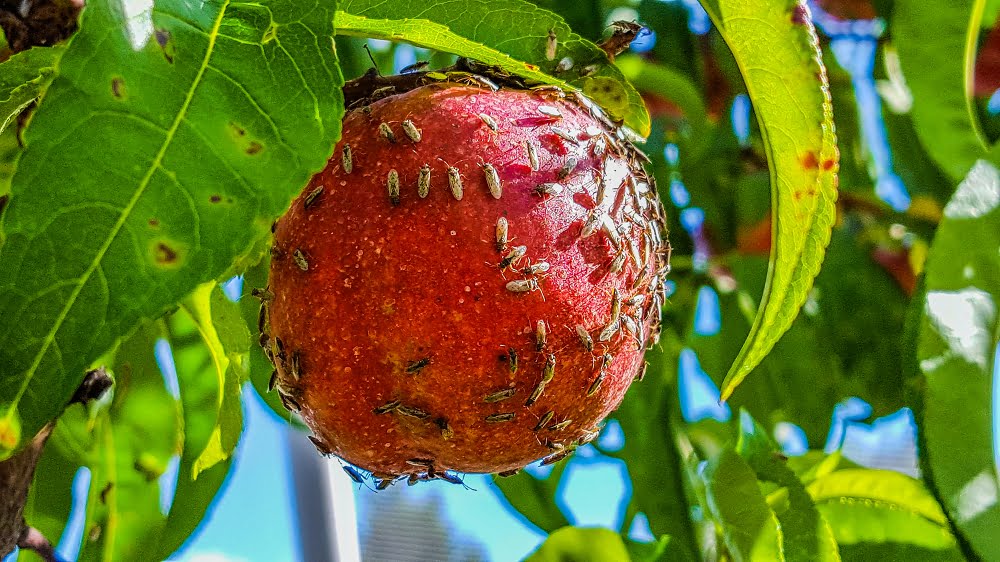
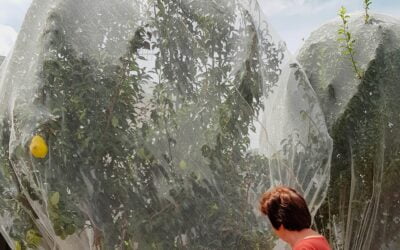

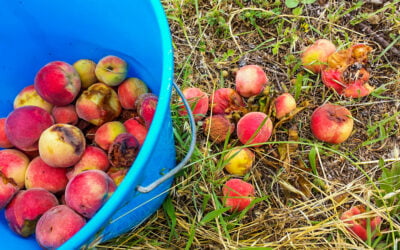
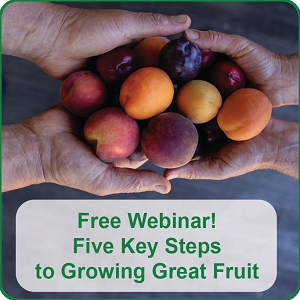
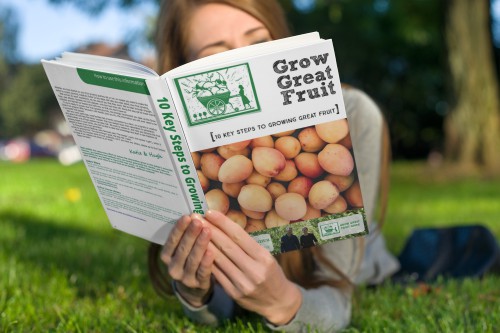
Birds are my problem. We have tried every tactic under the sun (netting, mirror, scarecrow, computer disks, pretend predators etc) to deter them but to no avail. They would demolish a whole tree of fruits within an hour and leave an absolute mess on the ground. With the nets, they get under, as the trees are getting quite tall and the nets do not quite reach the ground and those clever birds know all the tricks of the trade to get to those fruits.
My husband got sick of cleaning up after them, and to my dismay and without my input, he decided to cut all the fruit trees right back. 🙁
Any advice on how to deal with those pesty birds?
Hi Lise, yes, birds are one of the commonest problems. The only sure-fire thing is to net them out. There’s various options for this, from netting individual limbs to structures over a whole orchard. We have some short courses you may find useful at growgreatfruit.com/online-courses
Cheers
Hi Lise – your husband has done the right thing – netting that doesn’t reach the ground is ineffective because, as you pointed out, the birds simply get in under the nets and eat your fruit. Trees that get too tall are simply hard work – mid winter spraying, netting and picking the fruit. I retired six months which has given me more time to work in the garden and tend to my fruit trees. This year for the first time my apricot tree, which is normally very productive, had only about 20 fruit and was getting too hard to net. So like your husband I cut the limbs back hard – by at least a third to a half – and the new growth since has been outstanding. When giving the tree a really good haircut I left two limbs alone making sure there was enough leaves to photosynthesise. So next season not only will the tree be easy to spray mid winter it will be so much easier to net – and hopefully back to full productivity next season or the one after. I’m going to do the same to my plum, nectarine and peach trees post harvest as they too have grown too large and rangy to net!
Hi Mark, we agree, pruning the trees back to a manageable height certainly makes it easier to make sure the netting reaches the ground, and the trees easier to manage as well. It is important to prune them the right way though, or you’ll have to manage too much growth, in the wrong places and you end up fighting with the trees for years. Use thinning cuts rather than heading cuts at the tops of the branches – we explain the technique in our short course called Pruning Mature Fruit Trees.
Hi Hugh, my neighbour is going on about new netting laws. Are they through yet? As far as I understand and the nets will be too small for the bees to get in and therefore useless in my vege garden and my strawberries. Do you have any confirmation about this please.
The new law is through unfortunately, but won’t come into effect until September 2021. It stipulates that the net must have a mesh size of 5 x 5 mm or less at full stretch. It doesn’t mean we won’t be able to use netting any more, but it does mean everyone will need a structure that allows the net to be removed/pegged up at certain times to allow bees and predator insects access to the trees and garden, and let down at other times to prevent bird and fruit fly damage to the produce. It also means the nets are going to be significantly more expensive to buy, which is very unfortunate!
Thanks Katie,
My garden is swarming with them 🙁 I will try to move my chooks around and hope that they will help with the infestation. I did post a question about them on Permaculture Vic FB Page and it seems that others are dealing with them this Summer too. Would it be ok to post a link to this page there?
Hi Nicole,
Yes, please feel free to share this post.
Cheers